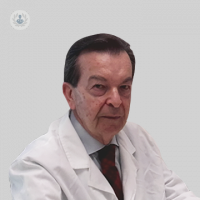Esophageal cancer: diagnosis and symptoms
Written by:Esophageal cancer is a rare tumor primarily in women, but has a high mortality rate. Worldwide currently it ranks eighth on other types of cancers. This incidence varies significantly depending on the geographical area, being higher in certain regions of South Asia and Central Africa.
 Only 10% of men with esophageal cancer survive more than 5 years, but fortunately survival is improving in most European countries.
Only 10% of men with esophageal cancer survive more than 5 years, but fortunately survival is improving in most European countries.
Currently there are two types of esophageal cancer: squamous and adenocarcinoma. The latter is gradually increasing its incidence in the developed world and already surpassing squamous. Factors causing esophageal cancer vary according to the two types. Barrett's esophagus and obesity are associated with esophageal adenocarcinomas, while consumption of snuff and alcohol are risk factors for squamous cell carcinoma.
What through which signals or testing we can detect cancer of the esophagus?
There is currently no useful test for the diagnosis of esophageal cancer in the general population. His study includes conducting a detailed and complete medical history with physical examination, blood tests (with markers CEA and SCC) and upper endoscopy with biopsy of suspicious lesions. For the study of the disease at the regional level EUS FNA biopsies used with lymph suspects. And for the possible spread of the disease to general or systemic level they are performed: TAC thoraco-abdominal-pelvic, bronchoscopy (depending on the location of the tumor), and PET-CT.
People diagnosed with potentially capable of malignant or premalignant lesions can benefit from conducting periodic endoscopies consisting exploration of the esophagus using a flexible tube called an endoscope.
The patients who most frequently this test is used are those who have been diagnosed with Barrett's esophagus. The endoscopy with biopsy, removal of small piece of tissue from the area for study under a microscope can detect premalignant stages (called dysplasia) so you can make a therapeutic decision. This attitude of diagnostic endoscopy may also be advisable in those affected by esophagitis gastroesophageal reflux disease that does not respond well to medical treatment.
If dysplasia is considered high-grade (pre malignant transformation) is advised surgery to remove the area of Barrett's esophagus or treatment by endoscopic means (depending on each case). It is also possible that the extracted tissue carcinoma small size that has not been visualized with the endoscope is detected. The prognosis in these cases is excellent.
With all the necessary diagnostic tests the extent of the disease and its corresponding staging (TNM) is set. So an initial forecast is made and can make a personalized treatment plan for each patient. All this, as well as the treatment is done by a multidisciplinary team of various specialists. Thus, the staging (identifying characteristics) of esophageal cancer is essential to properly raise treatment step.
Symptoms of esophageal cancer
In the initial phase of the disease usually no symptoms, so in these conditions the diagnosis is usually accidental and unexpected finding as for other reasons. However, most cases are diagnosed when there are certain symptoms.
The most common symptoms are:
- Dysphagia is the most common symptom of esophageal cancer. Is the difficulty in swallowing along with the feeling of detention at the level of the throat or chest. Usually it begins with solid foods, especially meat and bread and progressively increases. This causes mainly based food liquid, and finally progresses to inability to swallow up the saliva.
• Weight loss: occurs in a high percentage of cases as the disease progresses. It is largely due to the difficulty feeding, as well as loss of appetite and metabolic changes.
• retrosternal pain: is a rare symptom that can occur in both benign and malignant processes. If it appears in a case of esophageal cancer denotes that is advanced.
• Other symptoms: If the tumor invades adjacent structures to the esophagus may appear cough, hiccup or dysphonia (hoarseness).
If a patient has any of these symptoms, see a specialist in General Surgery to perform the necessary tests and diagnose. As these symptoms sometimes appear in benign conditions, must await the result of tests to establish a diagnosis.
Edited by Roser Berner Ubasos.


